考古學怎樣告訴我們關於保羅在居比路的行程(徒十三4-12)?
作者﹕David W.J. Gill
張逸萍譯自﹕https://www.christiananswers.net/q-abr/abr-a020.html
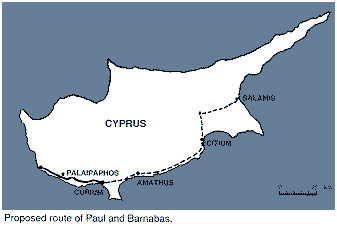
序言
保羅和巴拿巴從海路抵居比路(今天的塞浦路斯)的撒拉米之前,“經過全島,直到帕弗”(徒十三6)。他們行程的其他時候,似乎都是利用羅馬建造的道路網絡。因此,離開居比路之後,到彼西底的安提阿的途中,保羅走的是亞古士督在主前6年建造的通過Sebaste的路。[1] 在馬其頓,經過Egnatia,作為從尼亞波利向西的路線。[2]
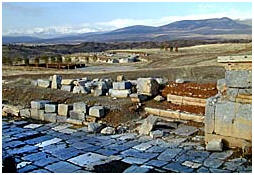 |
|
保羅和巴拿巴向彼西底的安提阿走,路上的廢墟。 Photo provided by ChristianAnswers Associate, BiblePlaces. |
居比路的行程把他們從居比路東岸帶到西部。這麼講,可能顯示這條路是通過島上一些最重要的城市。但是,首先要了解這個省份的發展。
這省是在主前58年(Badian
1965)獲得的,雖然居比路早些時已被認為是“羅馬的朋友和同盟”之一。[3] 最初它成為羅馬的基利家省的附屬地[4]。在主前48/7,該島回到埃及的控制之下。主前31年,克利歐佩特拉(Cleopatra)的死,使居比路又回到了羅馬統治之下。隨後在主前22年,亞古士督使居比路成為在方伯御營地位下的長老省之一。島上沒有羅馬殖民地。
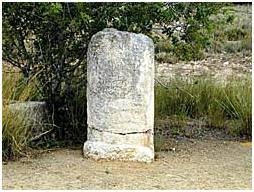 |
|
一個羅馬里程碑 Photo
provided by ChristianAnswers Associate, BiblePlaces. |
羅馬居比路的道路
有兩個證據可以顯示撒拉米和帕弗之間有一條路:首先是羅馬路線;其次是里程碑。列出路線和其間距離的“波伊廷格地地圖”(Peutinger Table)顯示,可能有兩條道開始於撒拉米(Miller 1916:827-29)。第一條路沿北岸的Kyrenia山脊上,向西北方到Chytri,然後沿著海岸前往Soli,Arsinoe(Marion),然後向南到帕弗。第二條路從南岸向Citium走,向西到Amathus,Curium,然後到帕弗。這些路線不是當代的,可能經過一段時間的形成的。距離可表列如下:
|
撒拉米 --
Tremithus |
18 英里 |
總共有115英里。[5] 通過北部海岸的另一條路則更長﹕從撒拉米到Soli,是88英里(或通經過Tremithus,是 71英里),然後經過Arsinoe再到帕弗,54英里,總共142英里。[6] 城市之間的距離也適合一天的旅程。這樣,從島的一端到另一端至少要六天的旅程。[7]
倖存下來的里程碑是最好的資料,可以決定這些路線的年代,它們經常有皇帝的名字(Mitford
1980:1333-35,n
213)。這些碑大部分都屬於四世紀,而且很可能屬於一段修理道路系統的時期,而不是擴張的時間。保羅和巴拿巴的旅程,至少在南岸,因有亞古士督統治期間所建造的羅馬公路,才能讓他們能成行。可見於離帕弗11里(羅馬),朝向Curium的一個里程碑(Mitford
1966:98-99 no. 3)。[8] 它寫著說:
[divif.]PONTIF[ex max.]
[trib.potest.-cos.-]
因為亞古士督被稱為
pontifex maximus,所以該工程必然在主前12年之後進行。[9] 雖然碑文只能確定帕弗和Curium之間有路,它可能向東延伸到撒拉米。下一個重大的發展是在Titus統治的81年七月至九月期間,[12] 在全省建設“新路”。 ([via]s novas; Corpus inscriptionum latinarumIII.6732)10] [11] 一個里程碑指出一條新路,從撒拉米向東北,到Agios Theodoros,又從那裡到達據推測是Carpasia的地方。[13] 在Flavian時期建造的其他道路,大概是亞古士督計劃的延伸。Mitford認為,橫過居比路中部,從Soli到撒拉米的路線,就是這些建築之一(1980:1336)。下一個主要的碑文系列,來自Severan時期。[14] 由於其中一些是沿著從帕弗到Curium的路旁被發現的,顯然這是修理工作的一部分。然而,正是從這個時期開始,有明確的跡象,顯示有一條路,從Soli到Arsinoe,然後向南到帕弗。[15]鑑於這些證據,我們認為,保羅和巴拿巴的最簡單路線,就是從撒拉米,沿著南部海岸走。
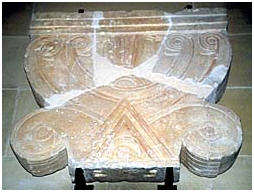 |
|
居比路7世紀的最初首都Aeolic。Photo
provided by ChristianAnswers Associate, BiblePlaces. |
保羅和巴拿巴到訪過的城市
保羅和巴拿巴到訪居比路時,使徒行傳中曾提到的城市,只有撒拉米和帕弗。然而,如果保羅和巴拿巴沿著南海岸的亞古士督路步行,[16] 在到達帕弗之前,他們會經過Citium,Amathus和Curium。[17]
由於公眾寺院的名望,其中三個城市在公元22年獲得了庇護權,[18] 就是撒拉米(Olympian Zeus; Mitford 1990:2189-90),Amathus(Aphrodite; Mitford 1990:2185)和帕弗(Paphian Aphrodite)。應該指出的是,雖然這些神明聽起來好像擬人的奧林匹克神〔希臘神話〕,其實有一些比較有區域的味道。例如,Paphian Aphrodite是一塊聖石(或baetyl〔譯按﹕有神聖來源而被膜拜的粗糙的石頭(如隕石)〕),而不是一個女神的雕像。[19] (譯按﹕Aphrodite通常翻譯為“愛芙羅黛蒂希臘女神”。)
Amathus附近記錄了類似的聖石膜拜。在Amathus附近的Agios Tychon發現了一個記錄“居比路女神”(Cyprian Aphrodite)的碑文,和“the Seven within the Stelai”的祭坊(Mitford 1980: 1302, no. 28; 1946: 40-42, no. 16)。[20] 是由羅馬居比路巡撫L. Bruttius Maximus舉行奉獻禮的(79/80)。據推測,這個祭坊有一個中央的baetyl,周圍有其他聖石。在東方,膜拜聖石,並不罕見。特別是著名的是被Elagabalus帶到羅馬的Emaesa Baetyl [21] ,或者在Perge的人,對Artemis神的膜拜 (Butcher 1988: 90, fig. 6.114)。
Paphian
女神的祭坊與皇帝的膜拜有關;對皇帝的膜拜與在Palaipaphos的女神祭坊也有關。例如,
Livia被確定為新的女神(Gardner, Hogarth
and James 1888: 242, no. 61),亞古士督的女兒Julia,就是Augusta
(Inscriptiones Graecae ad Res Romanas Pertinentes III.940)。其他與皇帝膜拜有關的銘文,包括對Amyntor兒子Lysias的敬稱﹕“皇室生活福樂的大祭司”
(Mitford 1990: 2197)。
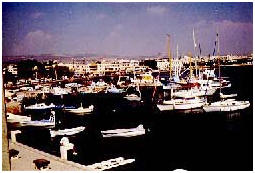 |
|
保羅登陸的居比路港口帕弗。 |
撒拉米和帕弗,是島上最重要的兩個城市。帕弗是省政府的所在地 (Mitford 1980: 1309-15)。就在這裡,保羅遇到島上的方伯士求保羅。[22] 帕弗建於主前312年左右,以取代Palaipaphos。主前二世紀時,它似乎已經成為島上的主要城市,突破了撒拉米的地位。[23]
這座城市在主前15年被地震破壞,亞古士督隨後給這城市
Augusta的頭銜(Mitford 1980: 1310, 有頭銜的細節)。這個城市還得到其他的榮譽,也許在尼祿(Nero)時,它得到Claudia的額外頭銜(Mitford 1980: 1310)。[24]帕弗在羅馬事務中的核心地位,可見於里程碑標記和它之間的距離。其他城市中,
Citium保留了早期腓尼基人過去的味道(Mitford 1980: 1318-20)。早期腓尼基的Eshmun膜拜,成為Asclepius〔譯按﹕希臘神醫〕的膜拜,在亞古士督之下活躍(Mitford 1980:1319)。主前一世紀的膜拜對象之一,或亞古士督的高級祭司的捐助人,有一個名字,叫做Asclepiodotus的兒子Asclepiodotus,這揭示了他與Asclepius的聯繫。[25]在這個城市的另一處,有一個拱廊,於主前41年獻給
Zeus Keraunios、神聖的Julius、女神 (Corpus Inscriptionum Graecarum 2641; Mitford 1990: 2195)。Amathus也有一個重要的,膜拜Hera的地點,當然在Claudian時期活躍的(Inscriptiones Graecae ad Res Romanas Pertinentes III.974)。[26]在衛城上發現了一個獻給亞古士督的祭壇(
Inscriptiones Graecae ad Res Romanas Pertinentes III.973)。位於城市西邊的Apollo Hylates的祭坊,可能是同時建設的。
總而言之,保羅和巴拿巴經過居比路的路線,把他們帶到島上幾個重要的城市,其中包括三個獲得庇護權的特殊地位的。行程表明,需時一個星期。這條路讓他們接觸到一些主要的膜拜中心,例如Palaipapos的女神祭坊,也把他們帶到在帕弗,就是該島的羅馬政府核心。
更多網上資料
註釋
-
For example: French 1994: 49-58; see also Mitchell 1993: 70.
For further information on the Anatolian road system: French
1980:698-729; 1988.
- Gill 1994:
409-10. Paul’s visit to Illyricum (Rom
15:19) may have used this route (Gill 1994: 410).
- The Roman
piracy laws of 101 or 100 BC reflect this status for Cyprus. For a
translation of the texts, see Sherk 1984, no. 55 (Delphi B, and
Knidos).
- Cicero was one
of the republican governors of the island, but did not apparently
land there, controlling it from Cilicia.
For a list of governors, see Mitford 1980: 1292. The first quaestor
for the island was not appointed until 49 BC.
- These are Roman
miles.
- These
itineraries do appear to be on the short side when compared to the
distances marked by the milestones. For example, there must be more
than 32 miles between Paphos and Curium (24 miles marked from
Paphos, and 8 miles marked from Curium), and more than 24 miles from
Arsinoe to Paphos (15
miles marked from Arsinoe, and 9 from Paphos) on a length that is
recorded as 24 miles long.
- Rapske (1994:
6) uses the estimate of 16-23 miles per day. The journey may have
been longer if Paul and Barnabas stayed in any one of the cities
along the way. Luke’s emphasis may imply that it was a straight
journey with no stops longer than an evening.
- The milestone
is now in the Kouklia museum.
- Compare the
date of 6 BC for the Via Sebaste which linked the Roman colonies of
southern Anatolia. See French 1980: 707, 708, map 2. The milestones
dating to 6 BC may be found in French 1988, nos. 267, 292, 293, 298,
391, 395, 498, 636, 663, 664, and 670.
- <10> This was
during the governorship of L. Plotius P---- (Mitford 1980: 1302, no.
29). See also Mitford 1939: 188-89.
- A second
milestone (Mitford 1980: 1335, no. 25) without recorded provenance
reads [ted eparche]iad.
- Compare the
development of the road system in Anatolia between AD 80 and 82
(Mitchell 1993: 124). The milestones of A. Caesennius Gallus “state
explicitly that he laid roads in the provinces of Galatia, Cappadocia,
Pontus, Pisidia, Paphlagonia, Lycaonia, and Armenia Minor”
(Mitchell 1993: 124). These are conveniently listed in French 1988:
507-508. French (1980: 711) takes the words via straverunt (or
stravit) in Anatolia to imply that these were paved roads replacing
earlier tracks.
- We should note
that this coincides with Flavian road building in Cilicia opposite
Carpasia (French 1988: 710, map 3, 712, map 4). The key milestone
comes from Ura and dates to AD 75-76 (Vespasian) (French 1988:
163-64, no. 461).
- Milestones from
this period also dominate in the archaeological record of Anatolia:
French 1980: diagram 7, opp. p. 720, where 68 examples are noted.
For a list: French 1988: 438-42.
- I reject
Mitford’s suggestion that “the circuit of Cyprus … was surely
devised as a single operation” (1980: 1335, n. 216). Compare the
development of the road system in Asia Minor, which emphasizes the
administrative centers: French 1980: 706, map 1, 707. I am grateful
to Prof. Stephen Mitchell for drawing my attention to the weakness
of Mitford’s argument.
- Land, rather
than sea, travel is implied by “through the whole of the island.”
- Tremithus is a
further possibility depending on the route from Salamis to Citium.
For the cities of Cyprus, see Jones 1971: 363-73.
- For the asylum
decree: Tacitus Annals 3.62.
- A
representation of the baetyl within the sanctuary can be found on
the coinage of Paphos: Butcher 1988: 59, pl. 5, nos. 53 and 54.
- The inscription
can be dated to 1 July-22 September 80.
- For a
convenient discussion of the cult see Millar 1993: 304-308. See also
Butcher 1988: 56, fig. 5.68.
- For the most
recent discussion, see Nobbs 1994:282-89.
- For details of
Salamis: Mitford 1980: 1321-23. The temple of Zeus Olympius adjoined
the main agora of the city. Augustus was
honored by the provincial high-priest Hyllos son of Hyllos in 12/11
BC (Mitford 1990: 2196).
- This may have
been linked to the establishment of games at Paphos in Nero’s honor.
- The inscription
honors Pnytarion; see Mitford 1961: 113-16, no. 15. Asclepiodorus,
her husband, was second founder and high priest of the cult of
Asclepius and Hygieia.
-
The inscription is dated to AD 50, see Mitford 1990: 2185. For details of Amathus, see Mitford 1980: 1315-17.
-
Badian, E. 1965 M. Porcius Cato and the Annexation and Early Administration of Cyprus.Journal of Roman Studies 55:110-21.
-
Butcher, K. 1988 Roman Provincial Coins: An Introduction to the “Greek Imperials.”London: Seaby.
-
French, D.H. 1980 “The Roman Road System of Asia Minor”. Pp. 698-729 in Aufstieg und Niedergang der r’mischen Welt II.7.2, eds. H. Temporini and W. Haase. Berlin.
-
1988 “Roman Roads and Milestones of Asia Minor”, fasc. 2: An Interim Catalogue of Milestones, British Archaeological Reports International Series 392, British Institute of Archaeology at Ankara monograph 9. Oxford: BAR.
-
1994 Acts and the Roman Roads of Asia Minor. Pp. 49-58 in The Book of Acts in its Graeco-Roman Setting, The Book of Acts in its First Century Setting 2, eds. D.W.J. Gill and C. Gemp. Grand Rapids: Eerdmans.
-
Gardner, E.A.; Hogarth, D.G.; and James, M.R. 1888 “Inscriptions of Kuklia and Amargetti.” Journal of Hellenic Studies 9.
-
Gill, D.W.J. 1994 Macedonia. In The Book of Acts in its Graeco-Roman Setting, The Book of Acts in its First Century Setting 2, eds. D.W.J. Gill and C. Gemp. Grand Rapids: Eerdmans.
-
Jones, A.H.M. 1971 The Cities of the Eastern Roman Empire (2nd ed.). Oxford: Clarendon Press.
-
Millar, F. 1993 The Roman Near East 31 BC-AD 337. Cambridge MA: Harvard University Press.
-
Miller, K. [1916] 1964 Itineraria Romana. Reprint. Rome: L’Erma di Bretschneider.
-
Mitchell, S. 1993 Anatolia: Land, Men and Gods in Asia Minor 1: The Celts and Impact of Roman Rule. Oxford: Clarendon Press.
-
Mitford, T.B. 1939 “Milestones in Western Cyprus”. Journal of Roman Studies 29.
1946 “Religious Documents from Roman Cyprus”. Journal of Hellenic Studies 66.
1961 “Further Contributions to the Epigraphy of Cyprus”. American Journal of Archaeology 65.
1966 “Three Milestones of Western Cyprus”. American Journal of Archaeology 70.
1980 “Roman Cyprus”. Aufstieg und Niedergang der r’mischen Welt II.7.2, eds. H. Temporini and W. Haase. Berlin.
1990 “The Cults of Roman Cyprus”. Aufstieg und Niedergang der rimischen Welt II.18.3, eds. H. Temporini and W. Haase.Berlin. -
Nobbs, A. 1994 Cyprus. In The Book of Acts in its Graeco-Roman Setting, The Book of Acts in its First Century Setting 2, eds. D.W.J. Gill and C. Gemp. Grand Rapids: Eerdmans.
-
Rapske, B. 1994 “Acts, Travel and Shipwreck”. In The Book of Acts in its Graeco-Roman Setting, The Book of Acts in its First Century Setting 2, eds. D.W.J. Gill and C. Gemp. Grand Rapids: Eerdmans.
-
Sherk, R.K. 1984 Rome and the Greek East to the Death of Augustus. Cambridge: CUP.
Author: David W.J. Gill as
excerpted from the Tyndale Bulletin 46.2 (1995): 219-228.
Supplied by Associates
for Biblical Research
Copyright
© 1995, David W.J. Gill, All Rights Reserved—except as
noted on attached “Usage
and Copyright” page that grants ChristianAnswers.Net
users generous rights for putting this page to work in their homes,
personal witnessing, churches and schools.
ChristianAnswers.Net
Christian Answers Network
PO Box 1167
Marysville WA 98270-1167